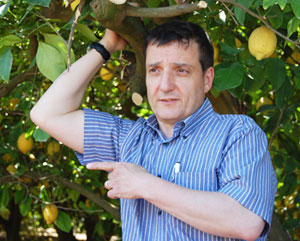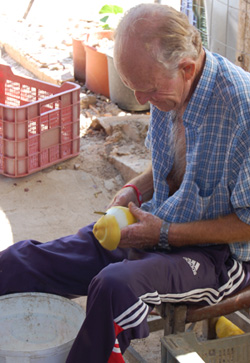When I was a kid, visits to the school careers adviser normally produced a slip of paper with ‘electrician’ or ‘engineer’ written on it.

These days, children probably get ‘web developer’ or ‘benefit cheat’ as their projected vocations, but in my day or now, I doubt ‘master of botanicals’ has cropped up very frequently.
It is a job that requires a stellar palate and a head for chemistry – a somewhat unlikely combination that Bombay Sapphire Master of Botanicals, Ivano Tonutti, has in spades.
Ivano is a softly-spoken chap who speaks more languages than is decent, and who spends the lion’s share of his time travelling the globe, visiting the people who produce Bombay’s 10 botanicals.
BarLifeUK were lucky enough to accompany him on one such trip to Murcia (pronounced Murthia, if you don’t want to sound stupid in educated company), to learn about lemons.
Murcia

Murcia can be found in the South East of Spain. It is a region that nestles in between the sea and mountains that protect it from harsh, cold winds. This is perfect lemon-growing country, and 80% of the region’s agriculture is devoted to citrus.
As we travelled to Los Ramos, one of lemon cultivation areas, with Ivano, I imagined the type of operation a brand the size of Bombay Sapphire would require – images of vast, mechanized harvests and computer-controlled irrigation came to mind.
I couldn’t have been further from the truth. In actual fact, Bombay Sapphire deal with hundreds of farmers, and almost everything is done by hand.
As we stood in the shade of a lemon tree while Ivano explained some of the finer points of its cultivation, the chap who owned the farm looked on. If BarLifeUK can be forgiven for dealing in lazy stereotypes, he looked every inch the rustic farmer and was clearly proud of his crop.
He then picked a lemon the size of a rugby ball (this is only a slight exaggeration) and with a flick of his wrist split it cleanly in half so we could taste the juice.
Several of our party tried to copy him with little success – this expert touch was something we experienced again later when it came to peeling lemons – which served to demonstrate how far removed these producers are from mass-produced, supermarket fair.
Lemons don’t grown on (lemon) trees, you know

Two things that Ivano told us surprised me. The first was that most lemons aren’t grown on lemon trees. The finca that we visited was actually full of red orange trees onto which lemon branches had been grafted. Apparently orange trees are hardier and better resist the very occasional spell of bad weather that Murcia experiences, making the laborious process of grafting worth while.
The second was the fact that it is lemon peel, not the juice, that is used by Bombay Sapphire as a botanical.
On reflection this made perfect sense when Ivano explained that the essential oils are contained in the skin and that Bombay Sapphire uses vapour infusion, which allows the dried peels (and the other botanicals) to be placed in a tank through which the distillate vapour passes during production.
At this point I thought some mechanisation must enter the process, as surely it would be impossible to peel the tons of lemons needed by hand. And once again, I was wrong.
We hopped back on the coach and drove to El Salar to meet a family typical of the region, who supplement their income by peeling lemons and selling the result to Ivano.
The walls surrounding the family’s home were covered with lines of drying lemon peels, and we watched an elderly gent peeling lemons with a knife that had clearly been used and sharpened for many years.
His technique was so practiced and so quick that he could peel a lemon in much the same time as it would take you to say “peel a lemon”.
A family affair

Bombay Sapphire collect peels from several thousand such families – some provide a few kilos, some several hundred – with the lemons themselves going on to make fruit juice or be used as animal fodder.
This was the major revelation of the trip for me. Instead of a huge ‘battery farm’ approach, Bombay Sapphire deal with thousands of individuals who produce lemons of the highest quality.
This approach is no doubt complicated to manage, and probably quite expensive, and yet it yields the best results, so they stick with it. It also helps keep the traditional family farming traditions of the region alive in increasingly cost-conscious times.
As we retired to our rather spectacular hilltop villa for the evening, Bombay Sapphire UK Brand Ambassador, Sam Carter, got behind the bar and started making Bombay Sapphire Collins using the juice from Murcia lemons, which were fantastic.
His recipe for the Murcia Collins, using Spanish lemon juice and peel is included below, and if you can get the lemons, we recommend you give it a bash.
Bombay Sapphire Murcia Collins
- 50ml Bombay Sapphire
- 25ml freshly squeezed Spanish lemon juice (remember they are slightly sweeter than other varieties)
- 10ml sugar syrup (or 1.5 teaspoons of caster sugar)
- 50ml soda or sparkling water
- Glass – Highball
- Garnish – super long lemon peel twist and a straw (please ensure you wash the lemon properly before peeling)
Method – do as the Spanish do, and like we saw, and spend time peeling the whole lemon in one go (go on, have a try!) – reserve to one side.
Add the freshly squeezed lemon juice, sugar and Bombay Sapphire to a clean highball glass. Stir thoroughly. Add plenty of cubed ice. Stir again. Top with soda water then stir for a final time.
Garnish with the lemon peel that you have created by feeding it into the glass until it’s fully submerged and twisted around the inside of the glass. Serve with a smile or, if it’s just for your pleasure, enjoy responsibly!

